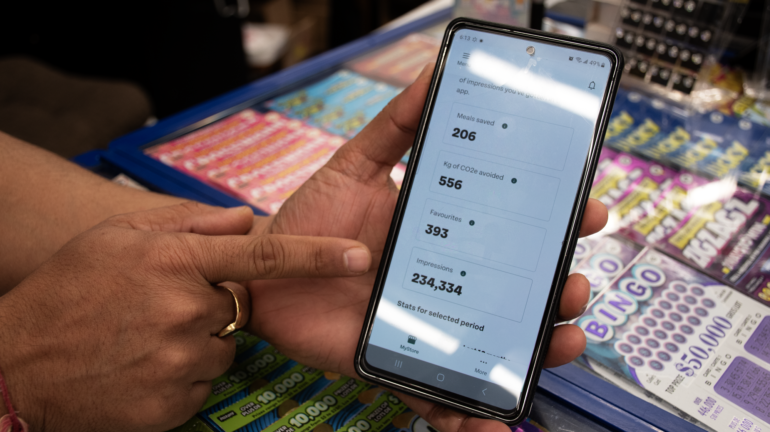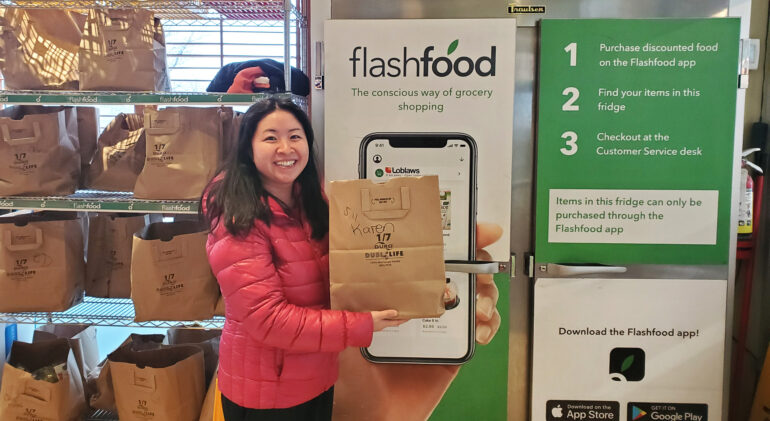Karen Mak, food and travel blogger behind stenoodie.com, was clearing out her fridge when she spotted six packs of strawberries for $5 on the Flashfood rescue app.
“That’s a really good deal,” Mak said. “I could pick it up on my way after [my kids’ classes], or sometimes I get my husband to pick it up.”
Mak, who works from her home in Markham, frequently checks her phone for the best deals on food rescue apps.
Mak regularly shops for grocery items via Flashfood and purchased nearly 300 bags from Too Good To Go, another food rescue app, last year. She is one of many Canadians seeking discounted groceries, meals, and baked goods once destined for the dump.

Karen Mak unpacks her haul from Flashfood app in her Markham home on April 11. Mak is one of many Canadians using food rescue apps to get better value for their groceries and treats. Photo credit: Courtesy/Karen Mak
A survey from Dalhousie University’s Agri-Food Analytics Lab showed that 73 per cent of food rescue app users who participated are motivated by savings, 34.5 per cent like the idea of rescuing food from going to landfills and 31.9 per cent use the app to discover new or unique food items.
In addition, baked goods were the most preferred food category for rescuing food through apps, followed by fresh produce, meat and ready-to-eat items.
Natalie Riediger, associate professor of food and human nutritional sciences at the University of Manitoba, said she thinks people have been using food rescue apps for discounts all along.
“You’re getting a better deal on foods that you normally wouldn’t otherwise be able to afford,” Riediger said.
She said using food rescue apps could reduce diet diversity and impact nutrition only if people limit themselves to the choices on the apps every day.
“If you’re unable to get any other food [for $4.99], I’m not going to suggest don’t do it,” said Riediger, whose research revolves around food equity for marginalized communities.
To give retailers flexibility, the food deals are promoted as “surprise bags” on the app. Depending on the store, the bags could contain random food items, such as baked goods, pantry staples or snacks.
However, Riediger said those who have severe allergies, celiac disease or conditions such as diabetes should not risk buying anything when they don’t know the ingredients.
Food safety of items approaching their best before dates can be a concern for some people, Riediger said.

A range of cheeses, meats, and juices for sale are on display in a fridge at Gateway Market on Walmer Road on April 16. Keith Warriner, a food microbiology professor, says the quality of foods also depends on how well and how long they’ve been stored. Photo credit: Annicca Albano
Keith Warriner, a food microbiology professor at the University of Guelph, said best-before dates protect consumers from being sold stale or old food but don’t necessarily guarantee safety.
Some foods, like fruit juices, don’t expire, Warriner said.
While Second Harvest offers a Best Before Timetable people can refer to, Warriner said, “I always say at the end of the day, use your senses.”
“Even when it says [half off], you’ve got to [open it up] and smell it and look,” he said.
Warriner said baked goods are typically safe due to their low moisture content, which prevents microbes that can cause sickness to grow.
Still, people should not take best-before dates for granted, Warriner said.
“I know you can say, ‘I’m gonna brave it,’ but [moulds, slimy texture and rotten smell are] nature’s way of telling you [not to],” he said.
For example, Warriner said moulds on strawberries release mycotoxins, which don’t kill anyone instantly but build up in the body and make every strawberry in the pack unsafe to consume.
He said food that needs refrigeration, such as meat, chilli and cream, is what people should be extra careful about.
Their shelf life depends on how well and how long they’ve been stored, Warriner said.
He said organic foods that don’t have preservatives have naturally short shelf life.
The former chef from the United Kingdom said food rescue apps are a gimmick, as restaurants only account for a maximum of five per cent of food waste.
In Too Good To Go’s 2023 impact report, one meal or 2.2 pounds of food is said to help avoid 5.9 pounds of CO2 emissions, 214 U.S. gallons of water use and 30.1 square feet of land use each year.
Sarah Soteroff, spokesperson for Too Good To Go, told Humber News that, at the same time, households in Canada save an average of $1,776 on food and groceries in a year.
“We almost never spoke about price until we started seeing food costs increase so steadily and so heavily,” Soteroff said.
Gateway Market, a small grocery store on Walmer Road in Toronto’s Hillcrest Village, has been open for two years and joined the app a few months later.

Taral Patel, owner of Gateway Market on Walmer Road, shows the impact report he received from the Too Good To Go food rescue app on April 16. Patel said he likes seeing the reviews and the number of people showing interest in his store. Photo credit: Annicca Albano
“It’s really crazy how much people are looking into [food rescuing],” owner Taral Patel said. “I would encourage everyone, even customers and the business owners, to register.”
Patel said he lists a few surprise bags twice a week or whenever he sees products he can no longer sell in the store past their best-before stamp.
He said he liked that the food could go to people rather than the landfill.
Kate Parizeau, a University of Guelph associate professor researching food waste, said it is a systemic issue that requires many different solutions, from business decisions to policy and cultural changes.
Still, the food rescue apps are valuable, encouraging people to consider their choices, Parizeau said.
“So much waste is invisible,” Parizeau said. “When we talk about food rescue, we think about low-quality food going to low-income people.”
Instead, she said, the apps acknowledge everyone needs to care about food waste, as suggested by the affordable to premium food and restaurant selection.
“Then the corollary is [people thinking] ‘let’s find some good income equality solutions for dealing with food insecurity,’” Parizeau said.

Karen Mak picks up her Flashfood haul from Loblaws in Richmond Hill on April 11. Mak says people need to check food rescue apps often to get their hands on the best items and deals before others do. Photo credit: Courtesy/Karen Mak
For Wade Thorhaug, executive director of Food Secure Canada, a guaranteed basic income could make food affordable for all.
Thorhaug said the food rescue apps typically require time, energy and credit cards some people may not have. The apps also don’t have much reach in rural or Indigenous communities experiencing extreme food insecurity like Nunavut.
For those who simply want to lessen their dependence on food retailers that control the price or quantity of things, he said shoppers could look into what exists locally.
“CSA boxes (farm-to-table food subscriptions) are often a really great source of really fresh local produce that hasn’t sat in a truck or a plane from California,” Thorhaug said.
He said people may also drop in farms with signs and pick up food.
For savings hunter Mak writing about her Toronto food rescue trips is her way of raising awareness of the issues and choices out there.
She said she’d like to see Walmart, T&T Supermarket and Food Basics on the app.
“Imagine how much more food can be saved if more people knew about it,” Mak said.

